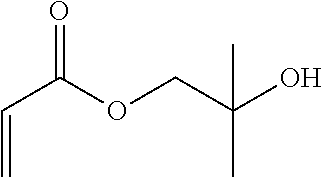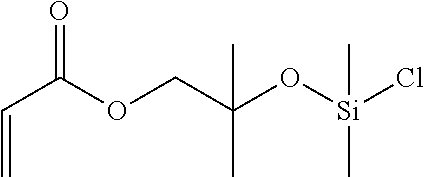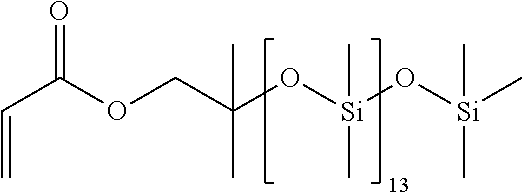Organosilicon compounds having (METH)acrylate groups and a process for preparation thereof
a technology of organic compounds and acrylate groups, which is applied in the field of organic compounds bearing (meth)acrylate groups, can solve the problems of unwanted secondary reactions, high cost and inconvenience, and costly reaction steps
- Summary
- Abstract
- Description
- Claims
- Application Information
AI Technical Summary
Benefits of technology
Problems solved by technology
Method used
Image
Examples
example 1 (
not in Accordance with the Present Invention)
Synthesis of the 2-hydroxy-2-methylpropyl Acrylate Precursor
[0079]
[0080]Under inert gas, triethylamine (66.8 g, 91.5 mL, 0.66 mol, 1.2 eq.) and 2-methylpropane-1,2-diol (49.6 g, 0.55 mol, 1 eq.) are initially charged in 300 mL of dichloromethane and cooled to 0° C. with an ice bath. A solution of 200 mL of dichloromethane and acryloyl chloride (49.8 g, 44.5 mL, 0.55 mol, 1 eq.) is added dropwise at room temperature via a dropping funnel in the course of an hour. A colorless precipitate was gradually formed in the course of the dropwise addition. The reaction solution was warmed to room temperature overnight and then the resultant precipitate was filtered off. The reaction solution was washed twice with 100 mL of water each time and dried over MgSO4. Then, the solvent was removed in a rotary evaporator and the crude product was distilled in vacuo. Boiling point 43-44° C. / 7.7-8.4 10−1 mbar. This gave 50.7 g (71%) of the pure product as a co...
example 2
imethylsilyl)oxy)]-2-methylpropyl Acrylate
[0083](formula III, R2═R3═R4=Me, R5═CH2, R6═H, b=2, c=1)
[0084]22.4 g (0.17 mol) of dichlorodimethylsilane were initially charged in the flask under argon. 5.00 g (35 mmol) of 2-hydroxy-2-methylpropyl acrylate, 4.05 g of triethylamine (40 mmol) and 10 ml of dry methyl tert-butyl ether were mixed under argon and added dropwise to dichloromethylsilane in the course of an hour under ice cooling. Following a reaction time of 2 hours, the ice bath was removed and the reaction continued at room temperature overnight. After the reaction had ended, the crude product was distilled to obtain 5.8 g (71%) of a clear colorless liquid of boiling point 41-44° C. / 0.41 mbar. Stabilization by admixture of 4-methoxyphenol and storage at 4° C. in the fridge.
[0085]1H NMR (CDCl3): δ=0.296 (s, 6H, (CH3)2SiCl), 1.21 (s, 6H, CH3), 3.89 (s, CH2), 5.69 (dd, JH,H=10.5 Hz, 1.5 Hz, 1H), 6.00 (dd, JH,H=10.5 Hz, 17.5 Hz, 1H), 6.28 ppm (dd, JH,H=1.5 Hz, 17.5 Hz, 1H).
[0086]13...
example 3
Functional Polysiloxane
[0088]
[0089]138 g (0.141 mol) of a terminally hydroxyl-functionalized polysiloxane (MW 980, chain length n=13) were diluted with 150 ml of methyl tert-butyl ether and admixed with 17.1 g (0.169 mmol) of triethylamine. Under argon and under agitation 40.0 g (0.169 mol) of [(chlorodimethylsilyl)oxy)]-2-methylpropyl acrylate (formula III, R2═R3═R4=Me, R5═CH2, R6═H, b=2, c=1) were admixed and the mixture was stirred at room temperature for 72 hours under exclusion of light. The ammonium salt formed as a solid material was filtered off. The organic phase was concentrated and then devolatilized in a short path evaporator at 70° C. / 4.2·10−2 mbar.
[0090]Yield 134 g (85.1%).
[0091]1H NMR (CDCl3): δ=0.025-0.150 (m, 72H, Si(CH3)2), 1.29 (s, 6H, CH3), 3.99 (s, 2H, CH2), 5.81 (dd, JH,H=10 Hz, 1.5 Hz, 1H), 6.13 (dd, JH,H=10 Hz, 17 Hz, 1H), 6.41 ppm (dd, JH,H=1.5 Hz, 17.5 Hz, 1H).
[0092]13C NMR (CDCl3): δ=1.04-1.13 (m, Si(CH3)2), 1.70-1.81 (m, Si(CH3)2), 26.97 (2C, CH3), 72.16 ...
PUM
| Property | Measurement | Unit |
|---|---|---|
| stability | aaaaa | aaaaa |
| hydrolytic stability | aaaaa | aaaaa |
| volatility | aaaaa | aaaaa |
Abstract
Description
Claims
Application Information
 Login to View More
Login to View More - R&D
- Intellectual Property
- Life Sciences
- Materials
- Tech Scout
- Unparalleled Data Quality
- Higher Quality Content
- 60% Fewer Hallucinations
Browse by: Latest US Patents, China's latest patents, Technical Efficacy Thesaurus, Application Domain, Technology Topic, Popular Technical Reports.
© 2025 PatSnap. All rights reserved.Legal|Privacy policy|Modern Slavery Act Transparency Statement|Sitemap|About US| Contact US: help@patsnap.com



